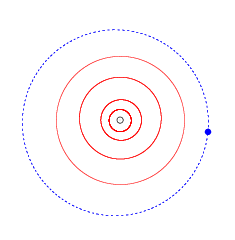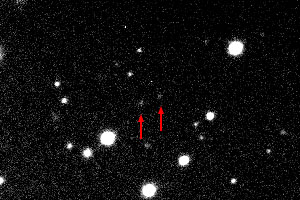Related Research Articles

A classical Kuiper belt object, also called a cubewano ( "QB1-o"), is a low-eccentricity Kuiper belt object (KBO) that orbits beyond Neptune and is not controlled by an orbital resonance with Neptune. Cubewanos have orbits with semi-major axes in the 40–50 AU range and, unlike Pluto, do not cross Neptune's orbit. That is, they have low-eccentricity and sometimes low-inclination orbits like the classical planets.

15760 Albion, provisional designation 1992 QB1, was the first trans-Neptunian object to be discovered after Pluto and Charon. Measuring about 108–167 kilometres in diameter, it was discovered in 1992 by David C. Jewitt and Jane X. Luu at the Mauna Kea Observatory, Hawaii. After the discovery, they dubbed the object "Smiley" and it was shortly hailed as the tenth planet by the press. It is a "cold" classical Kuiper belt object and gave rise to the name cubewano for this kind of object, after the QB1 portion of its designation. Decoding its provisional designation, "QB1" reveals that it was the 27th object found in the second half of August of that year. As of January 2018, around 2,400 further objects have been found beyond Neptune, a majority of which are classical Kuiper belt objects. It was named after Albion from William Blake's mythology.

1998 WW31, is a non-resonant trans-Neptunian object and binary system from the Kuiper belt located in the outermost region of the Solar System, approximately 148 kilometers (92 miles) in diameter. It was first observed on 18 November 1998, by American astronomer Marc Buie and Robert Millis at the Kitt Peak National Observatory in Arizona, United States. In December 2000, a minor-planet moon, designated S/2000 (1998 WW31) 1 with a diameter of 123 kilometers (76 miles), was discovered in its orbit. After Charon in 1978, it was the first of nearly 100 satellites since discovered in the outer Solar System.

53311 Deucalion, provisional designation 1999 HU11, is a trans-Neptunian object from the classical Kuiper belt, with a diameter of approximately 130–210 kilometers (81–130 miles), located in the outermost region of the Solar System. The cubewano belongs to the cold population and was discovered on 18 April 1999, by the Deep Ecliptic Survey at the Kitt Peak National Observatory in Arizona, United States. It was named after Deucalion, from Greek mythology.
(15807) 1994 GV9, provisional designation 1994 GV9, is a trans-Neptunian object from the classical Kuiper belt located in the outermost region of the Solar System. The cubewano belongs to the orbitally unexcited cold population. It was discovered on 15 April 1994, by astronomers David Jewitt and Jun Chen at the Mauna Kea Observatories, near Hilo, Hawaii.
(85627) 1998 HP151, provisional designation 1998 HP151, is a trans-Neptunian object from the classical Kuiper belt, located in the outermost region of the Solar System. The cubewano belongs to the cold population. It has a perihelion (closest approach to the Sun) at 40.297 AU and an aphelion (farthest approach from the Sun) of 48.306 AU. It is about 146 km in diameter. It was discovered on 28 April 1998, at the Mauna Kea Observatory, Hawaii.
(79983) 1999 DF9 is a trans-Neptunian object of the Kuiper belt, classified as a non-resonant cubewano, that measures approximately 270 kilometers in diameter.
(35671) 1998 SN165, prov. designation: 1998 SN165, is a trans-Neptunian object from the Kuiper belt located in the outermost region of the Solar System. It was discovered on 23 September 1998, by American astronomer Arianna Gleason at the Kitt Peak National Observatory near Tucson, Arizona. The cold classical Kuiper belt object is a dwarf planet candidate, as it measures approximately 400 kilometers (250 miles) in diameter. It has a grey-blue color (BB) and a rotation period of 8.8 hours. As of 2021, it has not been named.
1995 GJ might be a trans-Neptunian object and/or high-inclination cubewano from the Kuiper belt in the outermost region of the Solar System, and based on the calculated distance and brightness is assumed to be approximately 175 kilometers in diameter. It is a lost minor planet that has only been observed six times on the nights of 3–4 April 1995, by David Jewitt and Jun Chen at the Mauna Kea Observatory, Hawaii, using the UH88 telescope, and has not been observed ever since. The object is estimated to have been discovered right at perihelion at a distance of 39±1900 AU from the Sun. On the night of discovery, the object is estimated to have been moving away from Earth at 16 km/s with the uncertainty in the velocity being an unrealistic ±238000 km/s.

2001 QW322 is a trans-Neptunian object and binary system of the Kuiper belt, located in the outermost region of the Solar System. The cubewano was discovered at the Mauna Kea Observatories on 27 July 2001, by JJ Kavelaars, Jean-Marc Petit, Brett Gladman, and Matthew Holman. Later in 2001, Kavelaars discovered that it is a binary system. The diameter of the two components are estimated at about 128 kilometers (80 miles) and 126 kilometers (78 miles).

(528381) 2008 ST291, provisional designation 2008 ST291, is a 1:6 resonant trans-Neptunian object located in the outermost region of the Solar System that takes almost a thousand years to complete an orbit around the Sun. It was discovered on 24 September 2008 by American astronomers Megan Schwamb, Michael Brown and David Rabinowitz at the Palomar Observatory in California, with no known earlier precovery images.
(78799) 2002 XW93, provisional designation 2002 XW93, is a trans-Neptunian object and centaur from the outer Solar System, approximately 500–600 kilometers (300–400 mi) in diameter. It was discovered on 10 December 2002, by astronomers at the Palomar Observatory in California.
(315530) 2008 AP129 is a trans-Neptunian object and possibly a cubewano from the outermost regions of the Solar System, approximately 480 kilometers in diameter. It was discovered on 11 January 2008, by American Michael E. Brown and Megan Schwamb at Palomar Observatory in California.
(523674) 2013 MA12, provisional designation 2013 MA12, is a classical trans-Neptunian object and dwarf planet candidate from the Kuiper belt, located in the outermost region of the Solar System, approximately 340 kilometers (210 miles) in diameter. The cubewano belongs to the hot population. It was discovered on 26 July 2011, by astronomers with the Pan-STARRS survey at Haleakala Observatory, Hawaii, United States.
(505448) 2013 SA100, provisional designation 2013 SA100 and also known as o3l79, is a trans-Neptunian object from the classical Kuiper belt in the outermost region of the Solar System. It was discovered on 5 August 2013, by astronomer with the Outer Solar System Origins Survey at the Mauna Kea Observatories, Hawaii, in the United States. The classical Kuiper belt object belongs to the hot population and is a weak dwarf planet candidate, approximately 260 kilometers (160 miles) in diameter.
(523702) 2014 HW199, provisional designation 2014 HW199, is a trans-Neptunian object from the classical Kuiper belt, located in the outermost region of the Solar System. It was discovered on 30 January 2011, by astronomers with the Pan-STARRS survey at Haleakala Observatory, Hawaii, United States. The classical Kuiper belt object is also a dwarf planet candidate, as it measures approximately 290 kilometers (180 miles) in diameter.
(523684) 2014 CQ23, provisional designation 2014 CQ23, is a trans-Neptunian object and cubewano from the Kuiper belt, located in the outermost region of the Solar System. It was discovered on 13 March 2011, by astronomers with the Pan-STARRS survey at Haleakala Observatory, Hawaii, United States. The classical Kuiper belt object belongs to the hot population and is a dwarf planet candidate, as it measures approximately 330 kilometers (210 miles) in diameter.
(523687) 2014 DF143, provisional designation 2014 DF143, is a trans-Neptunian object and cubewano from the Kuiper belt, located in the outermost region of the Solar System. It was discovered on 12 April 2011, by astronomers with the Pan-STARRS survey at Haleakala Observatory, Hawaii, United States. The classical Kuiper belt object belongs to the hot population and is a dwarf planet candidate, as it measures approximately 350 kilometers (220 miles) in diameter.
(495603) 2015 AM281, provisional designation 2015 AM281, is a resonant trans-Neptunian object in the outermost region of the Solar System, guesstimated at approximately 470 kilometers (290 miles) in diameter. It was discovered on 13 March 2010, by astronomers with the Pan-STARRS survey at Haleakala Observatory, Hawaii, United States.
(505624) 2014 GU53, provisional designation 2014 GU53, is a trans-Neptunian object and cubewano from the Kuiper belt, located in the outermost region of the Solar System. It was discovered on 8 April 2014, by astronomers with the Pan-STARRS survey at Haleakala Observatory, Hawaii, United States. The classical Kuiper belt object belongs to the hot population and is a dwarf planet candidate, as it measures approximately 330 kilometers (210 miles) in diameter.
References
- 1 2 3 4 "JPL Small-Body Database Browser: 19255 (1994 VK8)" (2000-11-27 last obs). Retrieved 8 April 2016.
- ↑ Marc W. Buie (1997-10-27). "Orbit Fit and Astrometric record for 19255". SwRI (Space Science Department). Retrieved 2008-09-29.
- 1 2 Wm. Robert Johnston (22 August 2008). "List of Known Trans-Neptunian Objects". Johnston's Archive. Archived from the original on 28 September 2008. Retrieved 2008-09-29.
- ↑ Brown, Mike. "How many dwarf planets are there in the Solar System" . Retrieved 2018-02-17.
- ↑ "MPEC 2008-O05 : Distant Minor Planets (2008 AUG. 2.0 TT)". Minor Planet Center. 2008-07-17. Archived from the original on 7 December 2008. Retrieved 2008-09-29.